20 Most Commonly Asked Questions About Cultivating Mushrooms on Logs
Growing mushrooms on logs is very rewarding. What’s better than having home grown mushrooms in your yard? They can’t get any fresher than that. However, growing mushrooms can come with its own subset of problems. Check out this troubleshooting write up about the most common questions and issues that arise with cultivating mushrooms on logs. And if you have additional questions or experiences that you would like to share, please drop a comment below 🙂
For instructions on how to grow shiitake on logs, please check out this blog entry.
Enjoy!
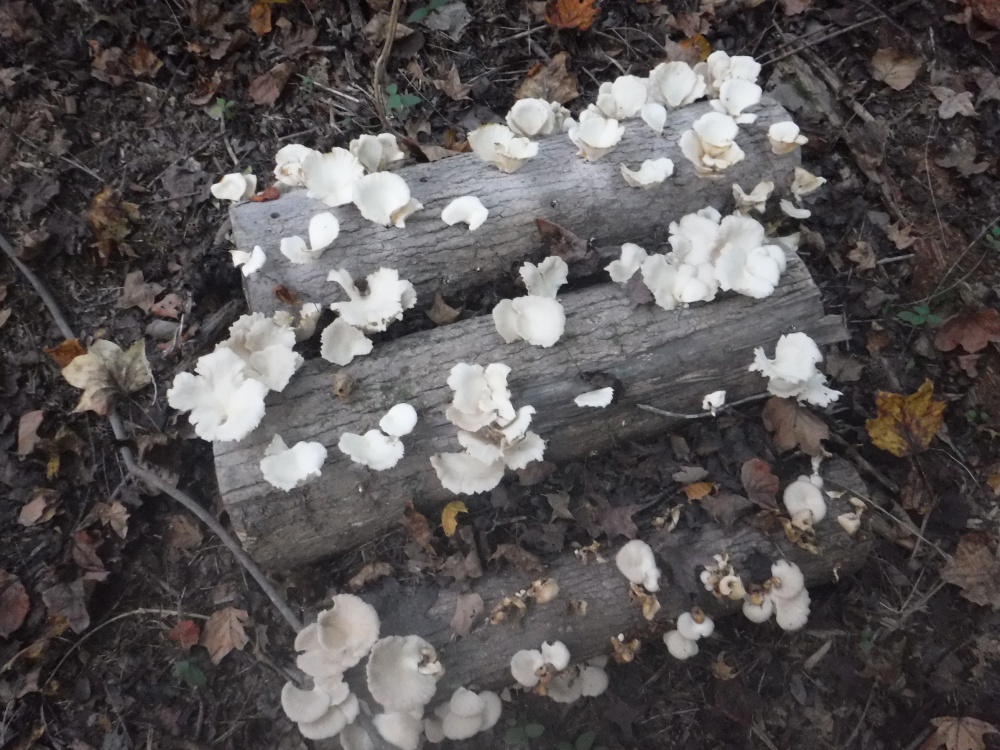
1. Can I inoculate logs any time of the year?
The most ideal time to cut logs is when the leaves have fallen off the trees, or have not emerged from the branches in the spring. This applies to growers that do a large amount of logs every season. If you are inoculating up to 15 logs, this does not apply, and you can cut logs year round.
2. I cut my logs 6 months ago? Can I inoculate them?
The answer is no. The window of inoculating hardwood logs is anywhere from 1 week to 6 weeks after cutting. In cooler climates, some growers cut logs in the fall, stack, and cover them with a tarp to overwinter, then inoculate in the spring. This might not work in hotter climates, as mushroom spores are floating around in the air year round.
3. My plugs do not look colonized, what should I do?
Most plugs or spawn should be fuzzy and white with mycelium, when you receive them in shipment. Exclusions are chicken of the woods (orange mycelium), lions mane (weak and whispy mycelium), nameko (orange brownish mycelium), etc, etc…. Although sometimes they can get shaken up in shipment, if you leave them in room temperature for a few days, they should recover. If they do not, do not open up the bags they are in, and please contact us with pictures so we can take a look if there is a further problem. Once you open the spawn up, we are not able to replace it.
4. My logs are not fruiting, what should I do?
When you send me an email asking this question, I will ask you several questions in return
– What type of spawn did you inoculate with?
– What did the spawn look like when you got it?
– What type of wood did you inoculate?
– When did you inoculate your logs?
– How long after you cut your logs did you wait to inoculate?
– Are your logs getting enough moisture?
– Do you see any white mycelium on the end of your logs?
– Can you send me a few pictures of your logs?
Please be prepared to answer all these questions, so I can help you figure out what is going on with your logs. Then email me. 🙂
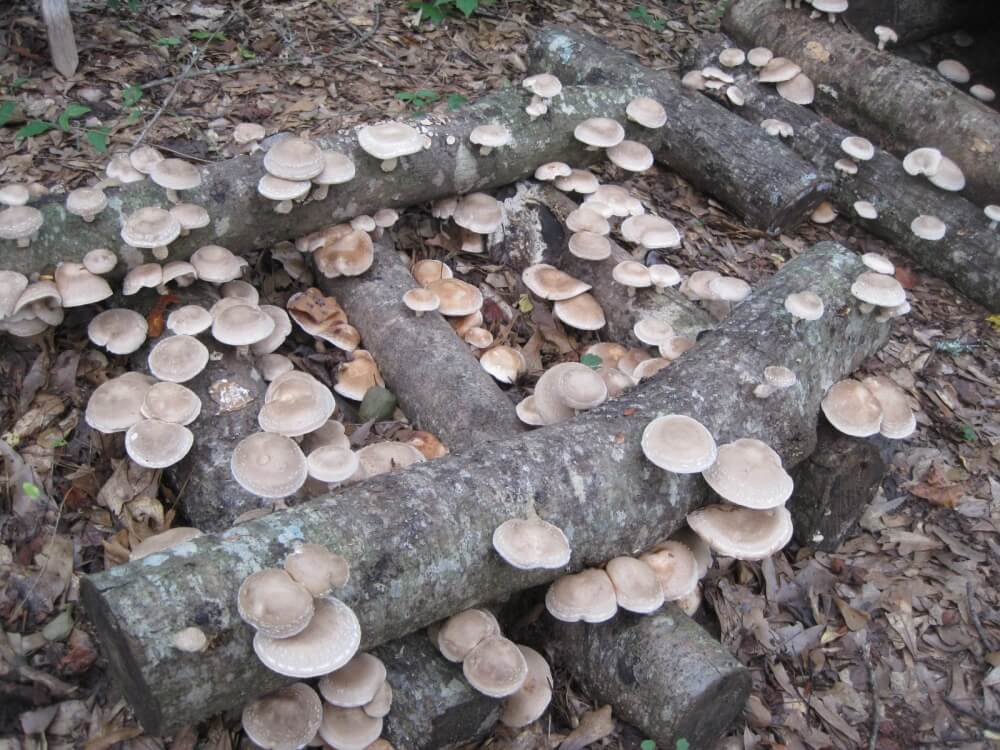
5. How long will my logs take to fruit?
This really depends on the type of wood and the size of your logs. Some types of wood are softer than others like sweet gum compared to oak, therefore the sweet gum logs will fruit quicker than oak for an example. If you plant an oak log that is 4 inches in diameter, and another that is 8 inches in diameter, but the same length, the smaller diameter log will fruit quicker, simply because it is smaller, and it doesn’t take as long for the mycelium to run all the way through. Logs fruit once the mycelium has completely populated the whole log. Generally it can take anywhere from 6-24 months for your logs to fruit, depending on the size, type of logs, your environment, and the strain of the mushroom you planted.
6. There are other mushrooms growing on my logs, is my log contaminated?
The sooner you inoculate your logs after cutting them, the less the probability of other hitchhikers on your logs. However, if you do have other mushrooms growing together with ones you planted, this is quite normal and OK. If you wait too long to inoculate your logs, those logs might get completely taken over by other competitors. In this case, it is probably best to start over. Please make sure that you do not eat mushrooms off your logs that you do not recognize. If you are unsure of what is growing on your logs, contact us via email with pictures.
Most common competitors you might see are:
– False Turkey Tails – Stereum ostrea
– Split Gill – Schizophylum commune
– Carbon Balls – Daldinia concentrica
– Diatrype – Diatrype stigma
– Brown Toothed Crust – Hydnochaete olivacea
– White Cheese Polypore – Tyromyces chioneus
– Purple Tinged Polypore – Trichaptum biforme
– Gilled Polypore – Lenzites betulina
– Turkey Tail – Trametes versicolor
7. Something has eaten the wax and the spawn I inoculated the logs with
Birds and insects will do this. Birds remove the wax off the logs, and use it for building their nests. And this is usually OK, as long as that wax was on there for about 1.5 weeks after you have inoculated your logs. The purpose of the wax is to keep the hole where you inoculated nice and moist, providing a good environment for the mycelium to jump onto the log.
8. Something is eating my mushrooms
It could be slugs, pleasing beetles, squirrels, chipmunks and even deer. Lots of people use greenhouse fabric to put under their logs to prevent beetles and slugs from coming through, but I don’t like recommending this, simply because it is not environmentally friendly. (should I remove this? It sounds kind preachy, no?) Some people set up beer traps around the logs, that slugs will be attracted to, and this is not a bad idea. You can also remove the slugs from your mushrooms and logs periodically, and find them a new home. I have never had a problem with squirrels, chipmunks and deer, but this problem is easily fixed, by protecting your logs with some kind of barrier, like fencing.
Pleasing beetles are quite the mushroom pest. They will not only eat the mushrooms, but make tunnels all throughout the caps and the stems. I see this mostly happening with oyster mushrooms, but can happen with other mushrooms as well. Unfortunately, there is not a way to prevent this, other than picking your mushrooms young, or having them in a room that is inaccessible to bugs. When I see tons of pleasing beetles on my mushrooms, I like to shake the mushrooms into a paper bag to remove the little pests. This way then cannot escape.
9. Can I grow mushrooms on logs indoors?
You sure can. If you don’t have a wooded or shady garden area available, you can also grow mushrooms on logs indoors or on your patio, but the logs have to be out of direct sunlight. Dappled sunlight is fine. If you chose to grow mushrooms on logs indoors, the best thing to do is to stand the logs up in a shallow dish of water, to keep the moisture flowing through the logs. Mycelium cannot move unless it has moisture available.
When the mushrooms start popping out of the logs, please make sure that you mist those babies very often to prevent them from drying out. Baby mushrooms are especially susceptible to stop growing and drying out, if they don’t have enough moisture. It is simply a defense mechanism of the mycelium inside the log. If it senses that the babies are not getting enough moisture, the system will abort to prevent too much energy expenditure.
10. How often should I water my logs?
Mycelium produces water as a byproduct of its metabolism. So it is essentially watering itself, but that doesn’t mean that the logs don’t need additional moisture. If your logs are touching the ground, they will wick some moisture out of the ground. If it hasn’t rained in two weeks, water your logs either with a sprinkler or soak them for 3-6 hours. If you are soaking them in tap water, let the water sit for about 2 days to allow for chlorine to evaporate before soaking your logs in it.
11. How often can I force fruit my logs?
Force fruiting is a term used when you soak your logs in water to promote fruiting. It is important to know that you should not be force fruiting your logs until after the first time they have fruited. Logs will only fruit for the first time if the mycelium has completed its run through the log. Think of it as a defense mechanism. Once it has not more food, the system wants to fruit, so it can create spores to reach more food source. After they have fruited for the first time, you may then force them by soaking in water every two months or so. This will of course depend on the strain of the mushrooms.
If you are wanting to force fruit cold blue oysters in the summer time, it will not work, as cold blue oyster mushrooms need cold weather to fruit. If you are soaking them in tap water, let the water sit for about 2 days to allow for chlorine to evaporate before soaking your logs in it. Do not soak your logs for longer than 24 hours, this will cause the mycelium to drown, and your logs will never fruit again.
12. I left my logs out in the sun. Is this OK?
No, this is not OK. Mycelium needs moisture to move. The sun drying out the log will prevent this very quickly. Leave your logs somewhere in the shade. Dappled sun is OK.
13. How do I get my logs to fruit quicker?
See #11.
14. When should I pick my mushrooms?
Pick your mushrooms before the caps have turned concave. Do not water your mushrooms on the day of picking. No one likes soggy mushrooms. When they are saturated with water, they will also rot quickly in storage.
15. Can I soak my logs to promote fruiting?
See #11.
16. Should I wax the ends of my log?
Waxing log ends is entirely unnecessary. Some growers do this to prevent contamination, but you are also preventing moisture from entering the logs this way.
17. What kind of wood should I use to plant my mushrooms?
Check out our Zone Fruiting Map for What Does It Grow and When Can I Plant It.
18. Should I use plugs or sawdust to inoculate my logs?
Either is equally effective. Using plugs is easier, cause all you gotta do is drill a hole and tap it into the log with a hammer. Using sawdust is a little bit more challenging and time consuming, but it is more cost effective if you are inoculating a large amount of logs.
19. My Chicken of the Woods and Maitake mushrooms have not fruited. What did I do wrong?
Growing Chicken of the Woods and Maitake is experimental. This means that the fruiting success rate is quite low. Some growers have fruited them by taking the stumps they planned to grow these strains on, and sterilized them before inoculating. How often this has been done is still unknown to definitely say that this method works. Maitake is plentiful in the wild in the fall, and Chicken of the Woods can be found growing starting in spring and throughout the fall.

20. I stacked my shiitake logs in a log cabin style. Is this OK?
Yes, this is a great way to grow shiitake mushrooms. The logs on the bottom will wick water out of the ground, and since all the logs will eventually fuse to create one organism, the water will be soaked up by all the logs in that stack.
Other stacking methods:
– Lean them against trees: shiitake, oysters, brick top, reishi, shimeji, turkey tail, enoki
– Bury them in the ground totem style (1/3 into the ground): Lion’s Mane, shiitake, oyster, chicken of the woods, maitake, brick top, cauliflower, oysters on larger logs, reishi, turkey tail, enoki
– Create a raft: Nameko, black poplar, brick top, chestnut, reishi, shimeji, turkey tail, enoki
– Let them sit in the creek, only one end of the log: shiitake, oysters, brick top, chestnut, reishi, shimeji, turkey tail, enoki
Additional Notes
Where can I find logs?
It can be difficult to find fresh cut logs. In the past when we didn’t have time to cut, I have reached out to friends on social media, searched on craigslist, or contacted local arborists to see if they have anything to offer.

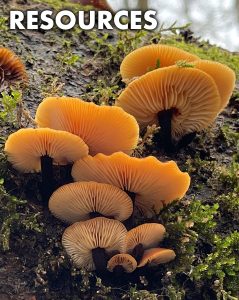

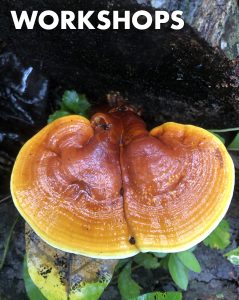
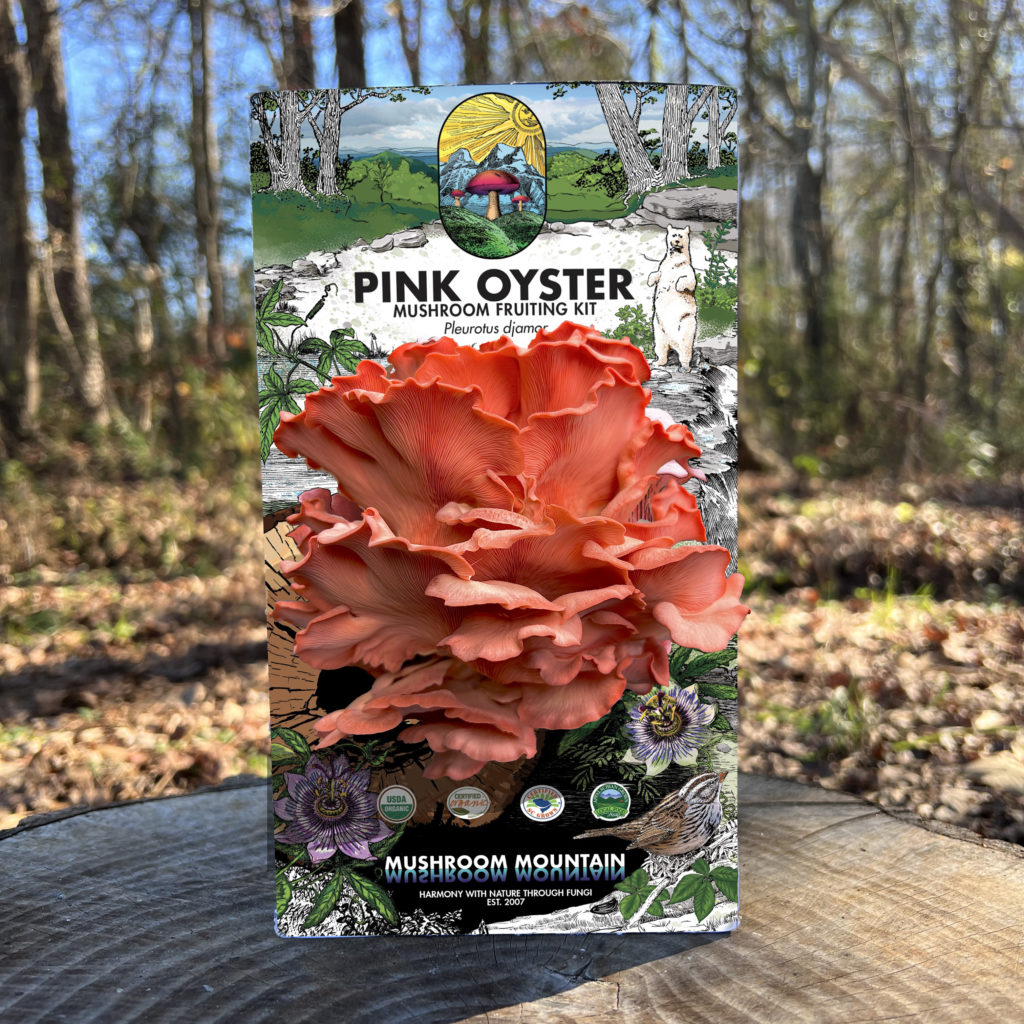



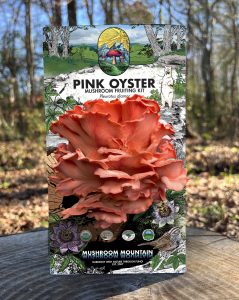
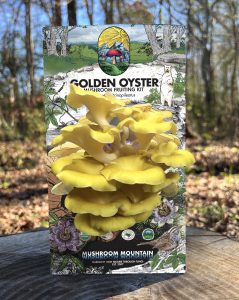
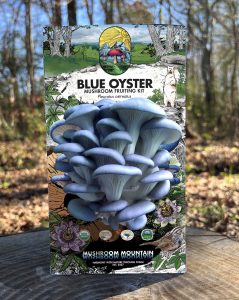
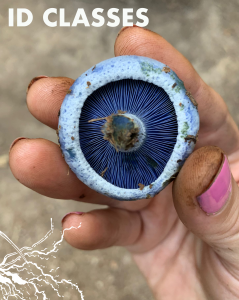

32 thoughts on “Log Mushroom Cultivation Troubleshooting Guide”
This was really helpful! Do you have the ability to provide FAQ sheets with this so that I can find this easily again?
Absolutely, I can PDF it, and put it on the FAQ page, and also Growing Manual Resources in the learn section of the website as a downloadable file. 🙂
You can download it and print it from this page 🙂 https://mushroommountain.com/growing-manual-resources/
Landscape fabric is approved for organic agriculture. The benefit to cost ratio is pretty high. I can’t speak for imports, but domestic fabrics don’t have nasties that leech out.
Yes, it is approved for organic agriculture, but is it compostable?
I inoculated some logs, only to find out I don’t have enough plugs. Can I reinoculate the logs when I have enough plugs?
Unfortunately no. Just leave them as is. You might get some weed fungi on there, but they should still fruit what you planted into them as well.
I am new to mushroom growing. What species/ varieties would you recommend for sw Montana.? Both indoors , oct- June and outside June- oct?
Hey Mike! Since you are a beginner, I would try any of the oyster fruiting kits. Shiitake fruiting kits are super easy as well. Those are for indoors.
https://shop.mushroommountain.com/collections/indoor-fruiting-kits
For outdoor cultivation, shiitake are super easy. Wide range and cold strains would do best for you: https://shop.mushroommountain.com/collections/plug-spawn/products/shiitake-plug-spawn-lentinula-edodes
🙂 Olga
Hey there, great info, thank you very much!
I have one question, i cut my poplar logs for growing oyster mushrooms, 2 months ago, can i still innoculate them??
thank you
You are definitely cutting it close. You may still inoculate them, but you might have hitchhikers on those logs: turkey tails, false turkey tails, parchment, and other “weed fungi”.
Do the mushrooms keep growing from year to year or is there something we need to do to keep them growing each year?
They do grow every year. It really depends on what kind of strain you inoculate with, but sometimes you can get more than two fruitings a year. If you are force-fruiting them, which means: soaking logs in water for about 6 hours, you can fruit them even more. But this also means that the lifespan of that log will be shorter. If you let them passively fruit for you, for every inch diameter of your log, that is how many years they will fruit 🙂 Just leave them in the shade somewhere, and they will do amazing for you.
How long can you store unopened packages of plugs in the refrigerator?
You can store it up to a year 🙂
I am new to this,plan to start this spring. For shade I have Spruce and Pine. Will this be ok? I have hardwood mixed with Spruce in my woods but that is 1/4 mile from my house.
It depends on what kind of mushrooms you want to grow really. Not much will grow on spruce and pine.
One comment from a totally infatuated beginner newbie; I have a lifetime supply of various hardwoods on my land but for those who do not there is one EXCELLENT source that is also endless that bring your local power company. When ever I need Bambi for the garden I just call my neighbor who is a local lineman. They clear right of ways year round and are usually swamped with biomass of all kinds after big storms pass through your area.
Being courteous is a no brainer but be sure to show concerns for safety and stay out of their way by asking and following instructions as to where to safely collect your wood. I bribe my neighbor regularly all summer with garden treats as they do not garden themselves but if you don’t know the crews personally liberal quantities of local lunch shop gift cards for the hungry crew will put you in their good graces and will remember you the next time you call.
Befriending someone with your county road maintenance crew is another group who always have biomass to discard.
Kindness is a spore of a different fruit enjoyed by both receiver and giver.
Wait…put down those rocks and clubs… I don’t use poor little Bambi in my garden, but I do use tons of BAMBOO!
I have a love/hate relationship with my spell check. I won’t discuss the relationship I occasionally have with Bambi’s daddy and uncles though so please don’t get to inquisitive and you won’t have to search around for any more clubs.
I dumbly failed to water my shiitake logs the past 2 summers during dry spells. They are not fruiting, even though I have tried to shock a few of the logs. Is it safe to assume the mycelium is dead?
Can I see your logs? Also how long have you soaked them for?
I’m curious about plant shoots that are growing out of my mushroom logs. Should I cut them off?
Can you give me more details on why the shoots are growing out of the logs? Are they newly cut logs? You can certainly cut them off, as they are not going to be beneficial at all to the grow.
Is this Ganoderma mushroom?
قارچ گانودرما
It is, yes 🙂
Any luck fruiting pink oysters on logs? I live in Florida so i’m wondering if its worth trying.
Does it freeze where you are at? If no, then you can grow them on logs. 🙂
Hello, my friend started growing mushrooms this spring , she did everything you have mentioned here, oak logs, right diameter, plugs, waxed holes and ends, soaked and kept moist, log cabin in the shade outdoors,
However the bark on some of the logs is falling off and it’s growing this greenish powdery looking mold, do you know what this is? What can she do about it? Is it all lost?
Hey Z! Can you post some photos of the logs? Did all of the bark fall off?
Hello, my friend started growing mushrooms this spring, she did everything you’re recommending here, shiitake mushrooms in freshly cut oak, right diameter, plugs, waxed holes and ends, log cabin stacked in the shade, soaked and kept moist, but no signs of anything happening, except that the bark is falling off and a green powdery mold is growing where the bark was, what is it? Is it all lost? And what can she do about it?
Thank you
Hey Z! Can you post some photos of the logs? Did all of the bark fall off?